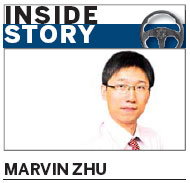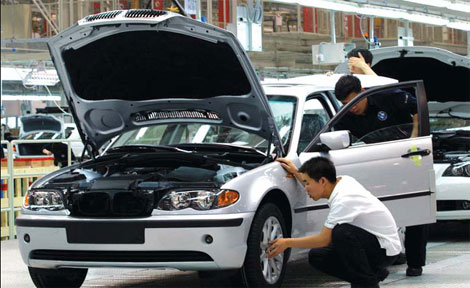Analyst: 2012 a watershed in auto market
Updated: 2012-02-06 07:58
By Marvin Zhu (China Daily)
|
|||||||||||
|
Factory engineers inspect a sedan on the assembly line of BMW Brilliance Automotive Ltd in Shenyang. While challenges abound, most foreign automakers are expanding production capacity in China. Natalie Behring / Bloomberg News |
Significant transitions ahead in policies, prices and products
As 2011 has drawn to a close, China's automotive industry has naturally turned its attention to this year's prospects.
While naysayers talk about a continued weak market and optimists speculate about a rebound, we at LMC Automotive prefer to focus on the key changes we can expect to see this year - as we expect there will be many.
We believe that 2012 will be a key transitional year in the development of China's automotive industry.
Economic pressures

The economic environment is one of the most critical factors driving the automotive market.
Influenced by both external and internal difficulties, China's GDP growth in 2012 will most likely fall below 9 percent, its lowest level since 2001.
The global economy is facing its greatest downward pressure since 2008, largely due to the debt crisis in the eurozone, slow recovery in US and Japanese markets and unrest in the Middle East and North Africa.
China, like all developing countries, will inevitably feel the effects of the downturn in mature markets through declining exports, retreating foreign capital and the increasing risk of inflation.
The domestic economy is also getting worse. Though some positive signals from tighter monetary policies have been seen, controlling inflation will remain a priority for Beijing this year.
A large number of projects were put on hold in the second half of 2011 - including high-speed railways, real estate developments and high-energy industries - due to a shortage of loans, and we believe the trend will continue through 2012.
A weak stock market and rising product prices will also dampen domestic consumption.
The old "three carriages" - investment, exports and consumption - carrying China's economy are struggling to pull with the same force as previous decades. Beijing is being forced to change the way it structures the economy and development.
We can expect increased domestic demand and a decreased reliance on exports. The year 2012 is the beginning of this fundamental transition.
Focus on environment
Policy continues to play a very important role in the development of the automotive industry. China's crown as the largest auto market in the world was assumed proudly, but environmental problems caused by soaring vehicle numbers is putting increased pressure on the government. Recent changes in taxation, fees and regulations indicate a transition in policy.
From Jan 1, vehicle and vessel taxes will be based on engine displacement, not the flat rate used before.
The tax on passenger vehicles below 2 liters will decrease up to 83 percent, while vehicles with engines larger than that will increase by up to 14 times.
Because buyers of large displacement cars are largely insensitive to cost, it is low-end small cars that will benefit most from reduced consumer expenses.
New policies also encourage R&D and use of more efficient turbo-charged engines. New sales tax regulations were also implemented at the start of the year to simplify procedures and remove fees in used car transactions.
The move is expected to accelerate turnover in the used car market and as a result stimulate new car sales. It also removes the purchase tax on electric cars, which will help stimulate sales in the long term.
Reductions in vehicle operating costs, including fuel and toll fees, will continue to benefit vehicle sales.
Last year 1,892 toll stations were removed, giving free access to another 94,000 km of highways. This year the first expressway built in China - from Shanghai to Jiaxing - will become toll-free after 23 years of service. We believe more highways will follow.
The pricing system on retail fuel is also expected to be more flexible in 2012. The National Development and Reform Commission - the country's top economic planner - will pass on responsibility for fuel pricing to fuel companies, which should shorten the lag in price changes.
Though the market will remain closed to foreign companies, we think the environment is at least starting to become healthier for the automotive industry.
Another change in policy is that foreign investment in vehicle manufacturing will no longer be encouraged. New vehicle joint ventures will not be approved by the NDRC and additional capacity at existing ventures will be more difficult.
Gas guzzlers
Since nearly every non-premium global carmaker has already entered China, the new policy will mostly impact luxury carmakers such as Land Rover and Lexus, which are planning to locally produce their gas-guzzling vehicles.
Investment in key components for new energy vehicles will be promoted in an effort to strengthen the emerging industry.
There are rumors that the government will release new stimulus policies this year, such as rural subsidies and trade-in subsides. But we think the chance is low because the development of the automotive industry has switched from being volume-oriented to long-term sustainability. Boosting sales at the cost of a polluted environment is no longer an option for decision makers.
Carmakers are changing their way of thinking and the market will diversify.
Foreign brands have started a new campaign of capacity expansion. Volkswagen will have new plants in Ningbo and Xinjiang, Nissan is adding a Dalian plant for Infiniti, and GM, Ford, PSA, Hyundai, Honda, BMW and Toyota will all have new plants ready for production in 2012. As their performance in other markets is expected to be weak, the booming Chinese market is a lifeline they can hold.
The main battlefield for global carmakers will move from compact to midsize cars. VW's Passat and Magotan and Buick's Regal and Lacrosse are competitive enough to challenge the traditional segment leaders - Accord, Camry and Teana.
Second-tier players, including the Mondeo, Sonata, K5, C5 and 508, are also competing hard with an ambition to challenge the top-of-the-segment players, which could bring higher profits and growing brand reputation as well.
Chinese brands are adopting different strategies. Sales targets have been de-emphasized, particularly for leading brands.
Chery has realized the failure of its "more products, more sales" strategy and has cut a number of new product programs and has started to focus resources on the vital few.
BYD, after a sluggish 2011, is now focused on improving product quality and a restructured sales network.
Great Wall has lowered its sales target for 2015 from 1.8 million units to 1.3 million units. For privately owned companies, profits take precedence over sales.
It is highly possible that the market share of the Chinese brands will continue to decline in this transitional year but we believe that sooner or later they will win it back if they stick to their revised strategies.
Overall, we expect the Chinese light vehicle market to grow 9 percent in 2012 to 19.7 million units. But, more importantly, we believe the year will be one in which the long-term sustainability of the market will be defined.
The author is a senior analyst at J.D. Power and Associates and LMC Automotive, who can be reached at MZhu@lmc-auto.com









